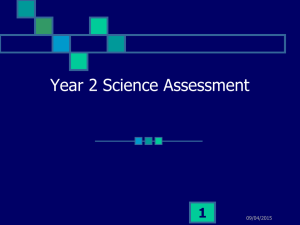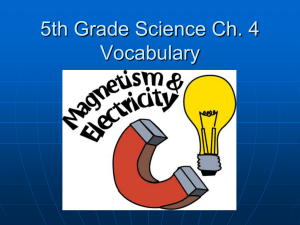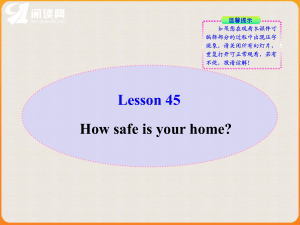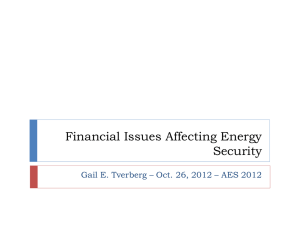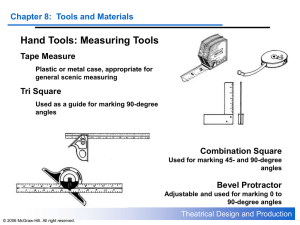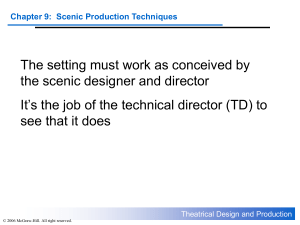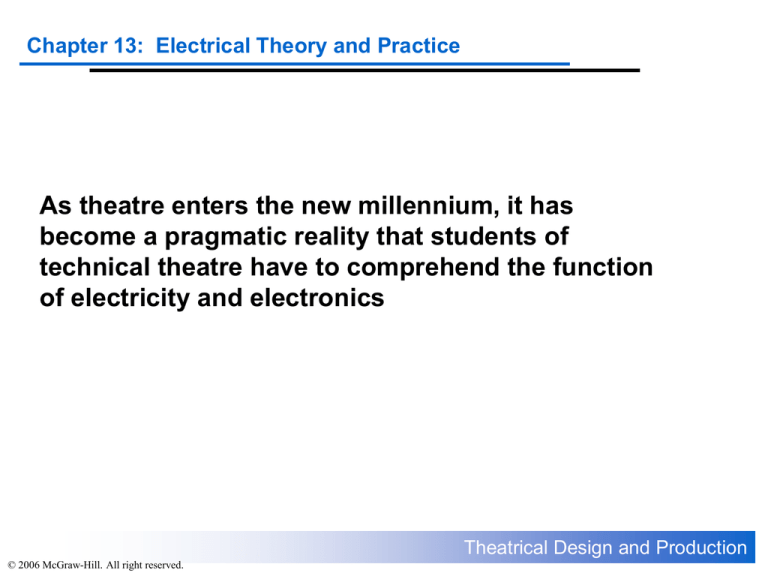
Chapter 13: Electrical Theory and Practice
As theatre enters the new millennium, it has
become a pragmatic reality that students of
technical theatre have to comprehend the function
of electricity and electronics
Theatrical Design and Production
© 2006 McGraw-Hill. All right reserved.
Chapter 13: Electrical Theory and Practice
Electricity at Work
Every electrical system must have three
parts
Source—origin of electrical potential
Load—device that converts electrical energy
into another form of energy
Circuit—pathway that the current follows as
it flows from the negative to the positive
terminal of the source
Theatrical Design and Production
© 2006 McGraw-Hill. All right reserved.
Chapter 13: Electrical Theory and Practice
Electricity at Work
Ohm’s Law
German physicist, Goerg Simon
Ohm, discovered in the 19th
century that some very basic
rules apply to the functioning of
electricity within a circuit
The law: As voltage increases,
current increases; as resistance
increases, current decreases
Theatrical Design and Production
© 2006 McGraw-Hill. All right reserved.
Chapter 13: Electrical Theory and Practice
Electricity at Work
The Power Formula
The Power Formula is much more useful
when dealing with higher-voltage electricity
This formula is used when it is necessary to
determine how much power will be consumed
by an electrical circuit
P=IE
W=VA
where
where
P=power in watts
W=power in watts
I=current in amperes
V=voltage in volts
E=voltage in volts
A=current in amperes
Theatrical Design and Production
© 2006 McGraw-Hill. All right reserved.
Chapter 13: Electrical Theory and Practice
Electricity at Work
Practical Information
The output-load voltage of dimming systems in the US is 117-120
volts alternating current (VAC)
The input voltage for most portable dimming systems is 220 VAC
The input voltage for most permanently mounted dimming
systems is either 220 or 440 VAC
The voltage figure that you will use in calculating the safe leading
capacity for dimmers is the out voltage—117-120 VAC
Theatrical Design and Production
© 2006 McGraw-Hill. All right reserved.
Chapter 13: Electrical Theory and Practice
Electricity at Work
Practical Information
Electrical wires and cables are designed to
carry specific current loads
Any electrical system is designed to work
within limits
If those limits are exceeded:
The protective devices will break the
continuity of the circuit—if they are in place
If not, the system will heat up and melt or
burn up
Theatrical Design and Production
© 2006 McGraw-Hill. All right reserved.
Chapter 13: Electrical Theory and Practice
Electricity at Work
Electrical Circuits
Three types of circuits:
Series
Parallel
Combination
Theatrical Design and Production
© 2006 McGraw-Hill. All right reserved.
Chapter 13: Electrical Theory and Practice
Electricity at Work
Electrical Circuits
Series Circuit
All of the electricity flows through every element of
the circuit. If any of the lamps burn out, the
circuit will be broken and no electricity will flow
to the other lamps
Theatrical Design and Production
© 2006 McGraw-Hill. All right reserved.
Chapter 13: Electrical Theory and Practice
Electricity at Work
Electrical Circuits
Parallel Circuit
Only a portion of the electricity flows through
each of the branches. If one lamp burns
out, electricity will continue to flow in the
rest of the circuit
Theatrical Design and Production
© 2006 McGraw-Hill. All right reserved.
Chapter 13: Electrical Theory and Practice
Electricity at Work
Electrical Circuits
Combination Circuit
Just like a light switch, this type of circuit is
controlled by a switch or dimmer
The parallel wiring of lamp outlets allows
individual lamps to be inserted on or removed
from the circuit without affecting its operation
Theatrical Design and Production
© 2006 McGraw-Hill. All right reserved.
Chapter 13: Electrical Theory and Practice
Electricity at Work
Electrical Current
There are two types of current
Direct—In DC, the electron flow is in one
direction only
Alternating—In AC, the electron flow
periodically changes polarity, which
causes it to change direction
Theatrical Design and Production
© 2006 McGraw-Hill. All right reserved.

